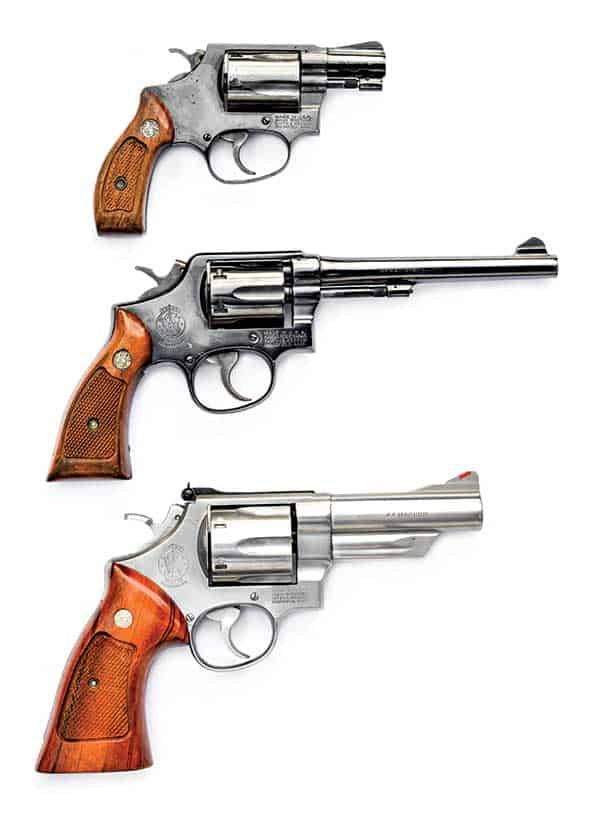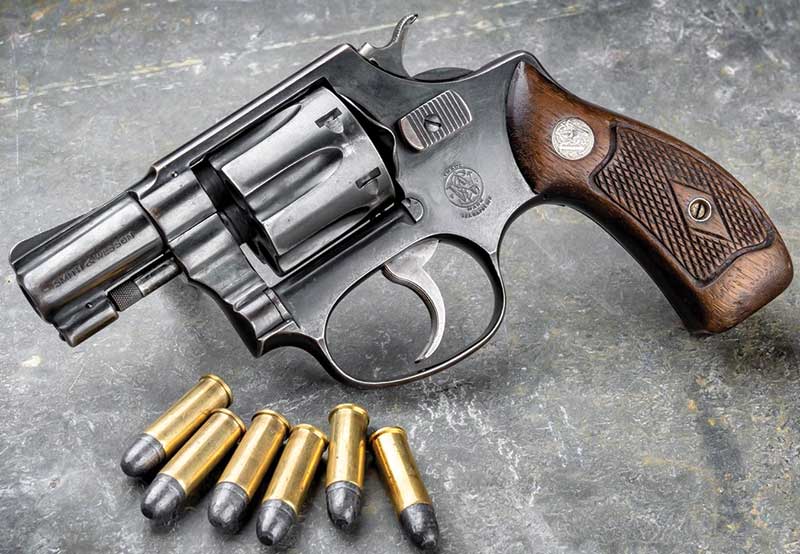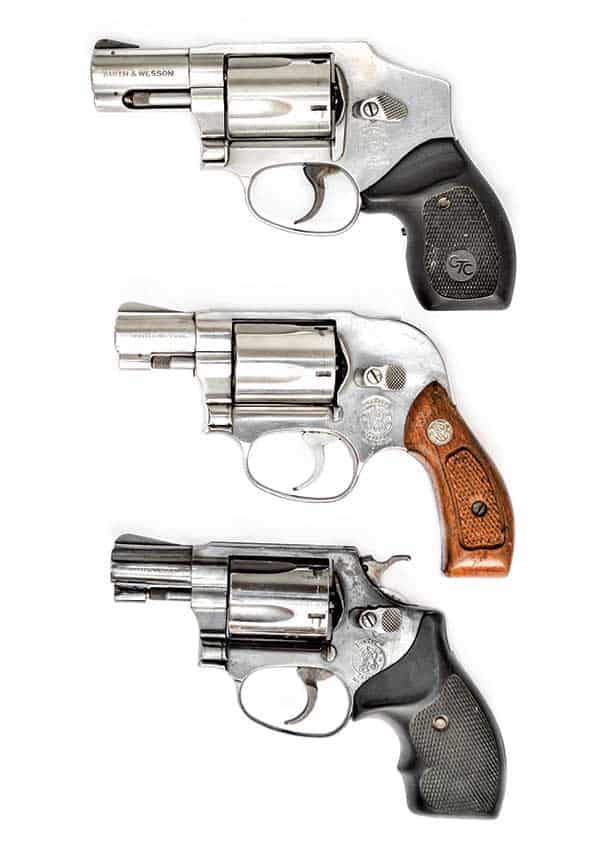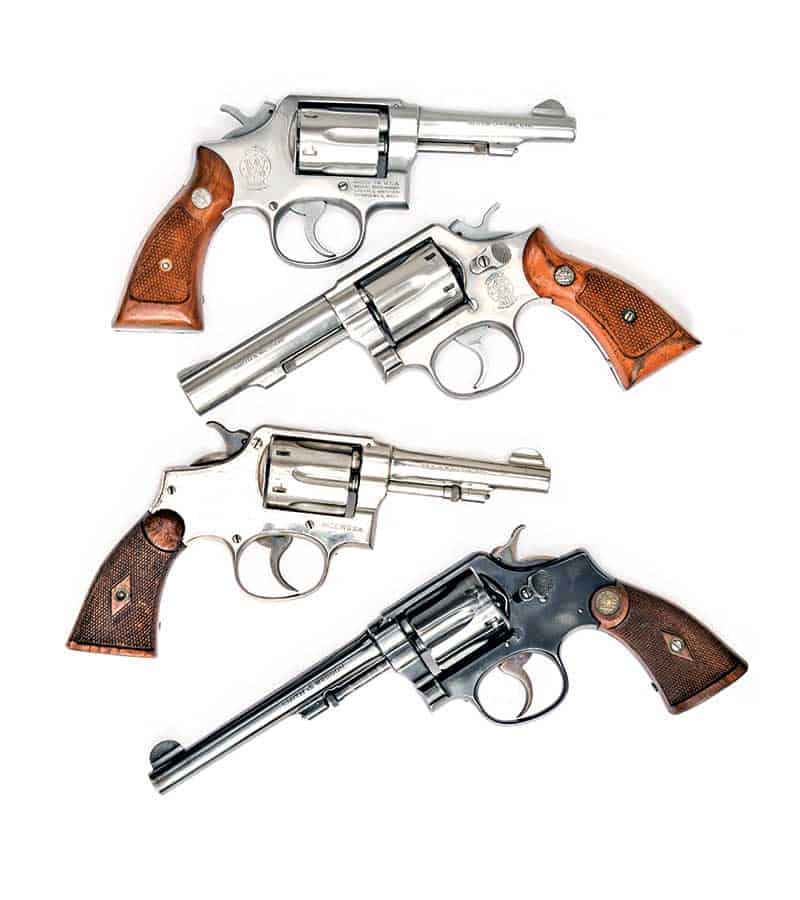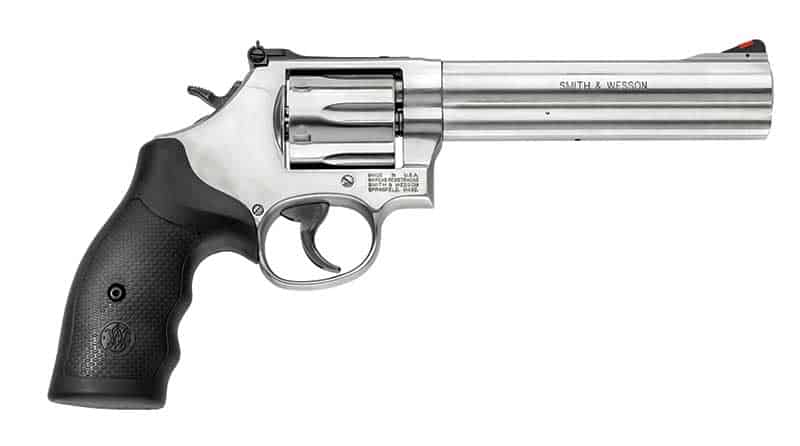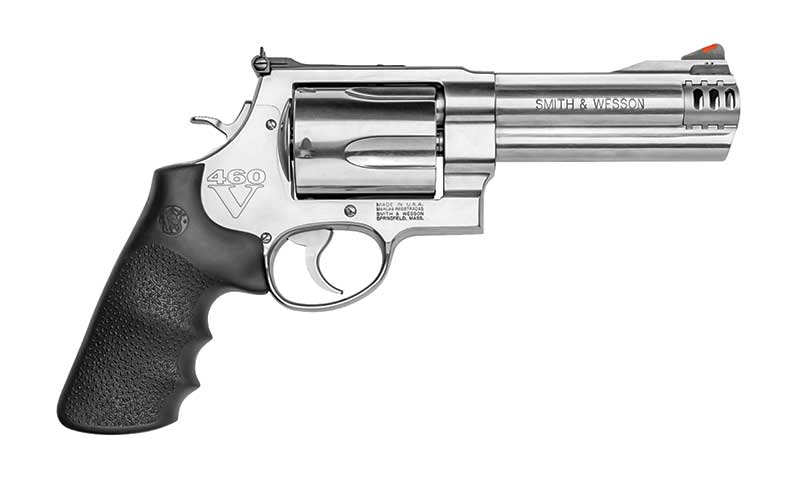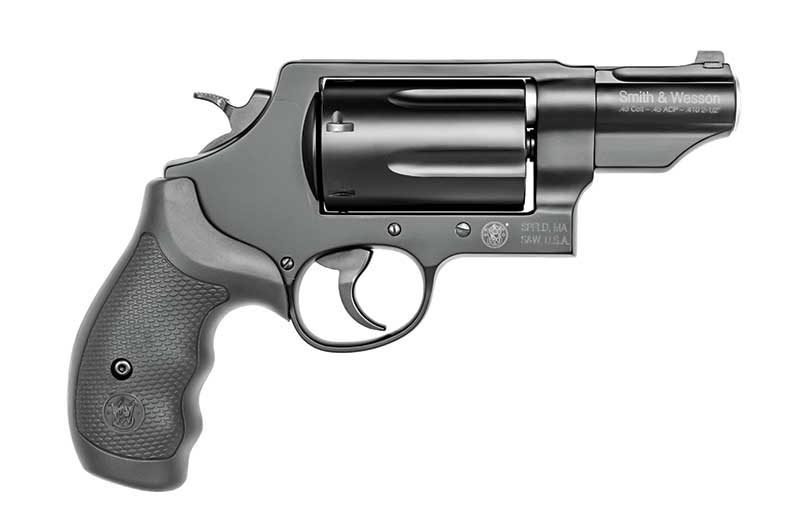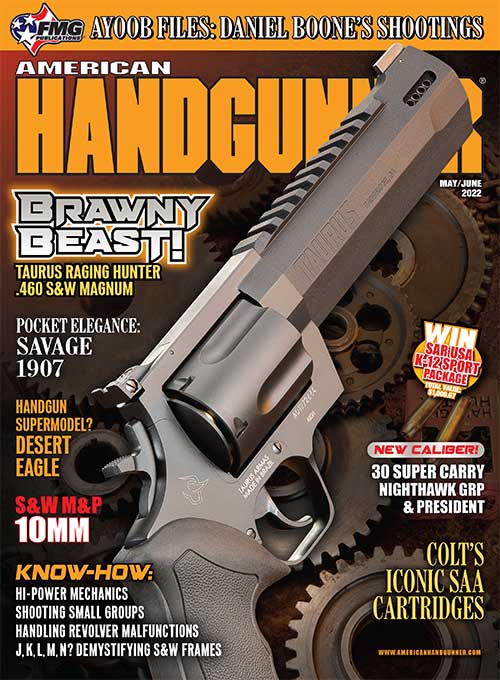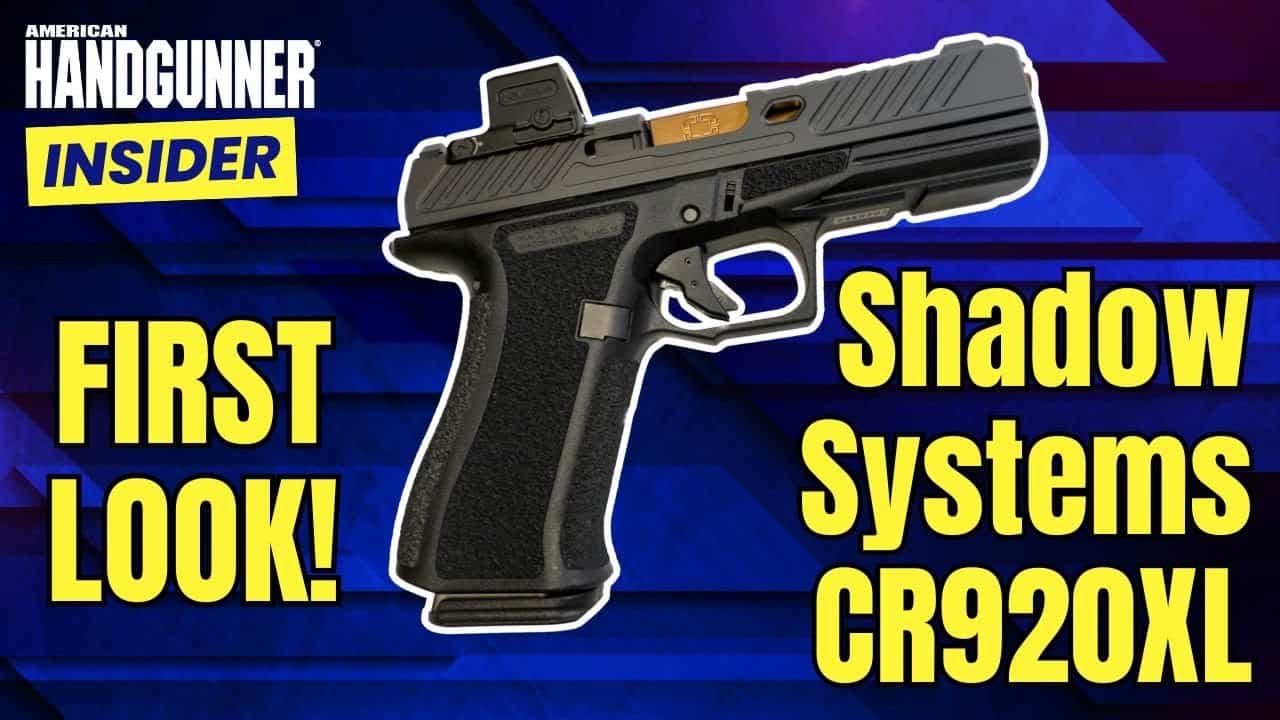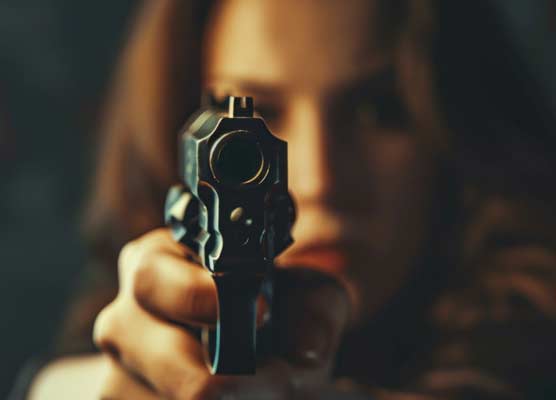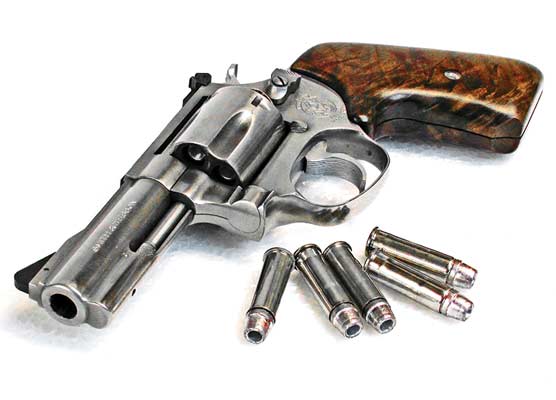J, K, L, N, M? E-I-E-I-O… Demystifying All Those S&W Frame Types
Regardless of the specifics of a particular revolver’s purpose, its ergonomics, size and weight always affect its shootability. Grip frame size and shape are more than just a matter of shooter comfort; they affect the handgun’s controllability in recoil and rapid double-action firing.
No revolver manufacturer has ever topped S&W regarding the sheer diversity of their revolver frame offerings. With so many to choose from, selecting the right one can seem a daunting task — at least until you understand what all those letters mean.
History Of Soup
The present alphabet soup of letter frame designations began at the end of the 19th century when S&W introduced their new solid-frame, swing-out cylinder, revolvers — the Hand Ejector models. The S&W’s unique frame lettering system goes back to the birth of the modern DA revolver we know today. Unlike the earlier numerical method, the letter system referred to frame size only and was not intended for marketing use.
The company produced swing-out cylinder revolvers on eight basic frames sizes. In order of their introduction, they are I, K, M, N, J, L, X and Z.
Except for the toy-like tiny M-Frame, if you laid out all the S&W frame sizes in alphabetical order, you’d observe increasingly large handguns whose cylinder windows grow to accommodate bigger calibers. That increasing physical size generally includes larger grip frames and more weight, but there are quite a few qualifications to those last two points. Except for the X- and Z-Frames, which are only made with round-butt K-sized grip frames, S&W offered all of their frames at one time or another with both full size, square-butt, grip frames and smaller round-butt grip frames. There’s much more to their revolver product line than small, medium and large.
M-Frame: Tiny & Delicate
The M-Frame, made from 1902 to about 1922, had petite proportions making it ideal for small hands. It was marketed as the Ladysmith. A seven-shot, it was chambered in .22 S&W Long.
I-Frame: Versatile
The I-Frame looks like a slightly shorter J-Frame. In truth, the J-Frame is a 1/4″ longer I-Frame. The I-Frame was the first of the Hand Ejector models to go into production in 1896 and was made up to 1960. It was also S&W’s first swing-out cylinder revolver. This compact frame was the basis for various six-shot .32 and .22 LR and five-shot .38 S&W caliber snubnose, police service, sporting and target models. This frame’s death knell was sounded by the growing popularity of the .38 S&W Special, which couldn’t fit in the I-Frame’s short cylinder window.
J-Frame: Pocket Firepower
The J-Frame was a powerful pocket .38 S&W Special snubnose introduced in 1950 to compete with Colt’s Detective Special. It had the same grip size as the I-Frame, but the cylinder window was lengthened. After 10 years of concurrent manufacture, S&W concluded there was not enough difference between the I- and J-Frame to warrant continued production of the former. Hence, the J-Frame took on all its predecessor’s roles. It’s now offered as a five-shot .38 S&W Special or .357 Magnum, an eight-shot .22LR and a seven-shot .22 Magnum.
The J-Frame was offered in more materials and styles than any other S&W frame. Begun in carbon steel by 1952, the first lightweight aluminum alloy Airweight models appeared. In 1965, the J-Frame Model 60 snub nose was S&W’s first stainless steel revolver. In 2002 S&W made the Model 360PD, a .357 Magnum snubnose with an amazingly light and strong aluminum/scandium alloy frame. It weighed only 11.3 oz. empty, compared to 14.3 oz. for the aluminum alloy Model 637 Chief’s Special Airweight and 19.5 oz. for the original carbon steel Model 36 Chief’s Special. The most recent J-Frame innovation is the M&P Bodyguard 38 snubnose featuring an entirely new aluminum alloy/polymer/steel composite frame weighing just 14.3 oz.
The first J-Frame was the Model 36 Chief’s Special with a conventional exposed hammer. In 1952, the concealed hammer Model 40 Centennial was first offered, followed in 1954 by the shrouded hammer Model 49 Bodyguard, which allowed thumb cocking for precise SA shooting. The modern versions of these vintage frames are still made today, in addition to a magnum length J-Frame with a 1/8″ longer cylinder window to accommodate the .357 Magnum cylinder. In 2001, key-operated internal locks were added to the left side of the frames, an unpopular feature that became standard on all S&W revolvers.
K-Frame: Perfection
S&W’s medium-sized Hand Ejector revolvers were based on the K-Frame and debuted in 1899 as the Military & Police model. The K-Frame was designed around a six-shot .38 caliber cylinder and a new cartridge significantly more potent than the .38 Long Colt then used by the U.S. Army.
Then, as now, the size and weight of the K-Frame are perfectly balanced with the .38 S&W Special cartridge for quick handling and shootability. The K-Frame was also slightly smaller, lighter and more graceful than its medium-frame Colt competitor. The K-Frame could be had in snubnosed, service, or target barrel lengths, with fixed or adjustable sights, round- or square-butt grip frames, carbon or stainless steel, and in .22 LR and .32 S&W Long target shooting models. Modern offerings include a 6-shot .22 Magnum, an 8-shot .22 WMR and 6- and 10-shot .22LR models.
S&W pushed the limit of the K-Frame when they began chambering it for .357 Magnum in late 1950. The K-Frame proved strong enough to handle a limited diet of 158-grain magnum loads.
L-Frame: Goldilocks
Law enforcement demand for a medium-sized revolver strong enough for long-term use with the preferred 125-grain JHP .357 Magnum load motivated the development of the L-Frame in 1986. The grip frame area of the L-Frame is identical to the K-Frame, but the upper portion was strengthened and enlarged. To give you an idea of how much bigger the L-Frame is, its cylinder can accommodate seven rounds to the K-Frame’s six. The L-Frames were made in carbon, and stainless steel and aluminum/Scandium alloy, with round and square butt grip frames, and as 6- or 7-shot .357 Magnums, 7-shot 9mm, or 5-shot .44 Magnums. All had adjustable sights. All in all, they proved a good compromise between power and shootability, smaller and faster handling than the massive N-Frames and stronger than the K-Frame.
N-Frame: Manly Frames
Many young men bought N-Frames hoping to grow hair on their chests. The N-Frame was the largest of the Hand Ejector frames and remained the company’s biggest and heaviest for nearly a century. Introduced in 1908, it was meant for the most potent .44 and .45 caliber cartridges of its day. Larger in every dimension, it had the steel to spare for long-term durability.
In 1935 it was selected to be the platform for the first .357 Magnum, and later the .44 and .41 Magnums. The great advantage of the N-Frame was its mass and strength, but it was not a pistol for those with small hands, and its size and weight made it a substantial load to carry by today’s standards. However, it was not overly burdensome compared to its big-bore peers. The S&W N-Frame remains the most graceful and lightest of the DA .44 Magnums revolvers.
Models were offered in round or square butt grip frames, with fixed or adjustable sites rear sights, and carbon steel, stainless steel, and aluminum/scandium alloy. N-Frames traditionally use six-shot cylinders, but eight-shot .357 Magnum and 9mm models were recently introduced, as well as a six-shot 10mm Auto.
X-Frame: King Kong?
Introduced in 2003, the biggest, heaviest and most powerful S&W hunting revolvers are built on X-Frames of stainless steel and have a five-shot capacity. Designed around the .500 S&W Magnum, they are the most powerful production revolvers in the world. They’re also chambered in .460 S&W Magnum, billed as the highest velocity pistol cartridge. Saying they are suitable for any large game animal in North America is something of an understatement.
A 4″-barrel X-Frame .500 Magnum is about 14 oz. heavier and 3/4″ longer than a 4″ barrel N-Frame .44 Magnum, but the X-Frame was designed with the K-Frame’s smaller grip frame, and a round one at that, for the same reason the L-Frame was. You can put larger stocks on a small grip frame if you have big hands, but you can’t put smaller stocks on a large grip frame.
Z-Frame: The Hybrid
The Z-Frame, introduced in 2011, is the newest frame size and close in size to the X-Frame but with a six-round, multi-caliber, cylinder chambered for 21/2″ .410 shotgun, .45 Colt, or .45 ACP ammunition. It is only used on the S&W Governor revolvers — snubnosed revolver-shotguns with rifled barrels that can also shoot pistol ammunition.
The Governor’s huge size alone gives it a formidable appearance. The gun only weighs 29.6 oz. empty because the Z-Frame is made in S&W’s super-light and super-strong aluminum/scandium alloy. To make it easier to handle, they utilized the K-Frame grip, selecting the round butt version for versatility.
Intended for close-in personal defense, the Z-Frame is made only with a fixed rear sight. The Governor revolvers have obvious merit as bedside pistols, but they would have been ideal to “repel boarders in a different time.” That being said, they could also prove well suited for defense while in a vehicle, or if you are an outlaw biker, for use in mounted marauding on the lawless highways and byways of a post-apocalyptic America driven to bankruptcy, social collapse and ultimate ruin.
And there you have it — revolver naming demystified.
Subscribe To American Handgunner

Get More Revolver Content Every Week!
Sign up for the Wheelgun Wednesday newsletter here:

